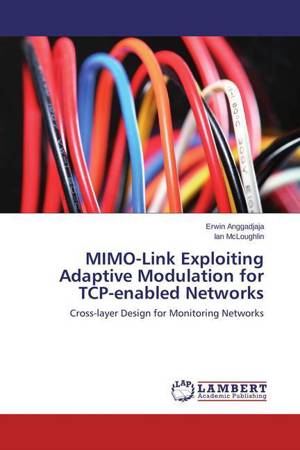
- Afhalen na 1 uur in een winkel met voorraad
- Gratis thuislevering in België vanaf € 30
- Ruim aanbod met 7 miljoen producten
- Afhalen na 1 uur in een winkel met voorraad
- Gratis thuislevering in België vanaf € 30
- Ruim aanbod met 7 miljoen producten
Zoeken
MIMO-Link Exploiting Adaptive Modulation for TCP-enabled Networks
Cross-layer Design for Monitoring Networks
Erwin Anggadjaja, Ian McLoughlin
Paperback | Engels
€ 57,95
+ 115 punten
Omschrijving
The effects of sub-channel packet routing and adaptive modulation (AM) are discussed in this book for MIMO linking system under differing channel conditions. The challenges is to exploit time-varying imbalances between logical sub-channels by different cross-layer routing and modulation strategies to improve overall goodput. MIMO sub-channels are modelled using OMNeT++ to form a single protocol link and then extended into the final interesting quad- parallel independent link model (Quad-PILM) to explore the effect of channel BER imbalance by implementing frame-by-frame sub-channel re-routing and retry mechanism with the aim of improving overall goodput. As a final model, a BER-directed adaptive modulation switching scheme is evaluated. The explanation in this book demonstrates that even quite simple switching heuristics and packet re-routing mechanisms can provide an overall improvement in a common real-world situation where MIMO sub-channels exhibit slightly unequal error rates for durations of one or more transmission frames.
Specificaties
Betrokkenen
- Auteur(s):
- Uitgeverij:
Inhoud
- Aantal bladzijden:
- 124
- Taal:
- Engels
Eigenschappen
- Productcode (EAN):
- 9783659662171
- Verschijningsdatum:
- 25/12/2014
- Uitvoering:
- Paperback
- Afmetingen:
- 150 mm x 220 mm
- Gewicht:
- 191 g

Alleen bij Standaard Boekhandel
+ 115 punten op je klantenkaart van Standaard Boekhandel
Beoordelingen
We publiceren alleen reviews die voldoen aan de voorwaarden voor reviews. Bekijk onze voorwaarden voor reviews.








